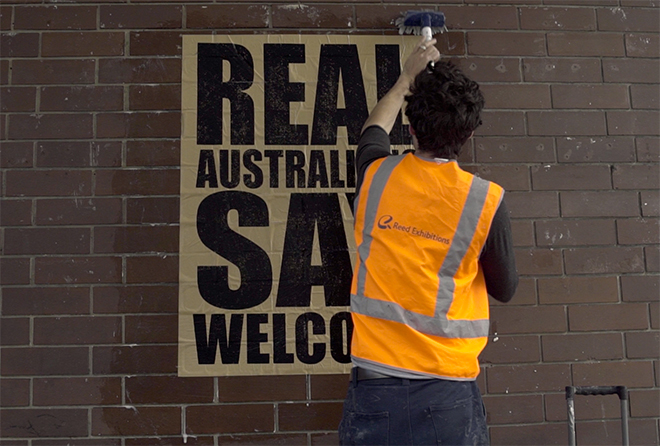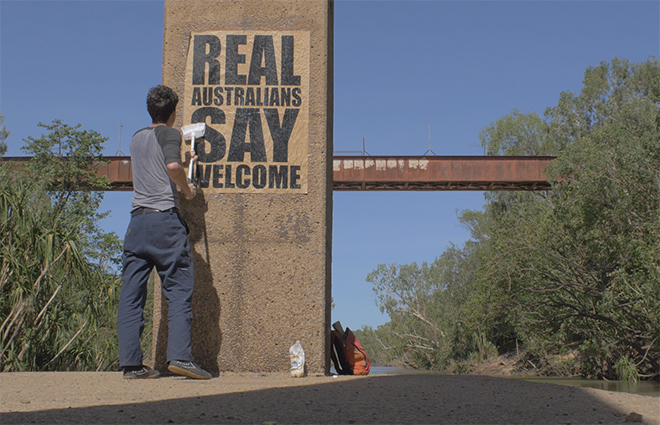This Street Artist Is On His Way To Canberra To Fight For Better Treatment Of Asylum Seekers
"I’m hoping to spend that week being as obnoxious as possible to politicians, showing them how much support we’ve got."

Peter Drew has had a weird couple of weeks. Since his campaign to plaster Australian capital cities with 1,000 “Real Australians Say Welcome” posters suddenly went viral last month, he’s been chased down the street, fielded the wrath of angry bigots online, featured on Russian TV and sparked a global conversation about Australia’s treatment of asylum seekers.
And he’s not done yet. With World Refugee Week coming up next month, the young Adelaide street artist is planning to target the Federal Government with a special trip to Canberra.
“I’m hoping to spend that week being as obnoxious as possible to politicians, showing them how much support we’ve got,” he says. “I think most people in Australia are really proud of us being a multicultural place but what we get these days is Australian politicians pandering to base fears of the electorate.”
–
A History Of Controversy
This won’t be the first time Drew’s stood up to authorities. In 2011, just a couple of years after taking up street art, he was arrested for vandalism; a charge he soon used as inspiration in a new work pasting 42 massive mugshots of 1920s criminals across Adelaide, initially without permission of the city council or property owners. He mainly chose criminals who’d been booked for innocuous offences that have since been decriminalised, drawing a parallel with the criminalisation of street art.
In 2013 he was almost kicked out of the renowned Glasgow School of Art and deported for continuing the very street art that had secured him the position in the first place. Even more ironically, he was there to write a thesis on institutions’ inability to embrace illegal street art. This eventually all inspired his Art vs Reality web series that critiques such arbitrary restrictions in the art world.
Drew has also used his art to explore national identity and refugee rights. After watching the 2013 Australian election from Scotland, dismayed at the recurrent “stop the boats” rhetoric, Drew returned home to create Bound for South Australia. In this project, he visited detention centres and talked to a number of asylum seekers before pasting 36 of their self-portraits and stories across Adelaide.
“Those were the first one-on-one conversations I’d had with asylum seekers,” he says. “I’d been as isolated in that respect as most Australians. I think if you just watch the news and don’t have any one-on-one human contact with [these] people, you’re going to get a pretty skewed view and it’s easy to convince yourself that you should be afraid.”
“I wanted to create a project that had a bit of sympathy for those people in the middle. It’s okay to feel fear but it’s how we respond to that fear, the choices that we make based on that fear, that decide our character as individuals and as a nation.”
–
‘For Those Who’ve Come Across The Seas / We’ve Boundless Plains To Share’
Drew created Real Australians Say Welcome after noticing the only people who seemed to remember the second verse of Australia’s national anthem besides long-suffering school children were immigrants who’d learnt it word-for-word as part of our citizenship test.
Then, after securing nearly $8,400 in crowd-funding via Pozible, Drew headed off around Australia. He plastered posters across public spaces and businesses, both with permission and without. At one point he even climbed onto the University of South Australia’s roof in broad daylight.
“I wear an orange hi-vis vest, which allows you to just do whatever you want,” he tells us.

On April 16, the project caught the eye of The Design Files editor Lucy Feagins, who put out a call via her hugely popular Instagram profile for artists to create their own spin-offs. An avalanche of artwork bearing Drew’s slogan immediately rolled in under the hashtag #realaustralianssaywelcome, thousands started sharing their own shots of his posters on the street, and at one point even South Africans got on board. The hashtag #realsouthafricanssaywelcome was used as both a stand of solidarity with the original campaign, and a statement about their own nation.
“I have to admit that I wasn’t cool enough to know what The Design Files were and I had to be told by wife because she is a fashion designer and much cooler than me,” Drew says. “But I quickly caught up and it was just amazing. I think as an artist, that’s the most you can hope for, that you can start something that inspires others to create and take ownership of.”
–
But Talking About “Real Australians” Can Be Difficult
Not everyone’s thrilled with the project, of course. Drew says he was literally chased down a Western Sydney street last month by a guy who took exception to the work. He’s copped his share of online hatred, too.
“I knew it was going to provoke people and especially a certain group of people that consider themselves ‘real’ Australians,” Drew says. “I wanted to pop that bubble but also create a way for ordinary Australians who are proud of multiculturalism to celebrate that and not feel pushed around by right-wing nationalists.”
Others have argued the slogan carries inherent racism because Drew is white. “‘Welcoming’ is an act of largesse by a rightful owner; a promise that can be revoked as soon as the guest oversteps the mark, and overstays their welcome,” Sanmati Verma wrote for New Matilda. “The ‘Welcome’ extended by white anti-racist protesters is at once an act of displacement of Indigenous sovereignty and a reminder of white supremacy, in an act of pretended largesse.”
Drew rejects that argument as “absurd” but says he spends “absolutely no time” worrying about that, focusing instead on the intended point. Initially, he hoped the project would encourage people to question their own attitudes, but he’s now realised it could directly affect asylum seekers too, especially in the wake of events like Easter’s violent anti-Muslim Reclaim Australia rallies.
“Just making asylum seekers feel at home or less threatened is something this project can definitely achieve,” he says.
–
So, What’s Next?
Before Drew hits Canberra for Refugee Week in June, he’s taking Real Australians Say Welcome to Perth, Brisbane and Tasmania. And, at the end of it all, he plans to release a video showing refugees asking Australians to fill in the blanks of the national anthem’s second verse.
“It’s just a great ironic situation where these asylum seekers are talking to Australians that don’t have a clue about their own anthem,” he says.
Of course, it’s no great crime to forget a few lines in a song, but Drew believes the message it holds is an important one. He says the reason we’re all so switched off to the plight of asylum seekers is that we don’t allow ourselves to empathise with the terrible situations they’ve often survived or escaped.
“It’s very difficult to carry that emotional weight, to carry the weight of all the trouble in the world,” he says. “So compassion is a very hard sell. That’s why I took the approach I did with this project, because irony and looking at our own identity is a much easier beginning.”

–
Koren Helbig is an Australian freelance writer living in Spain. She has written for publications including New Internationalist, frankie, Kill Your Darlings and The Lifted Brow, and in a former life she covered the colourful world of Queensland politics for The Courier-Mail. Koren blogs at She Makes Magic and tweets at @KorenHelbig.